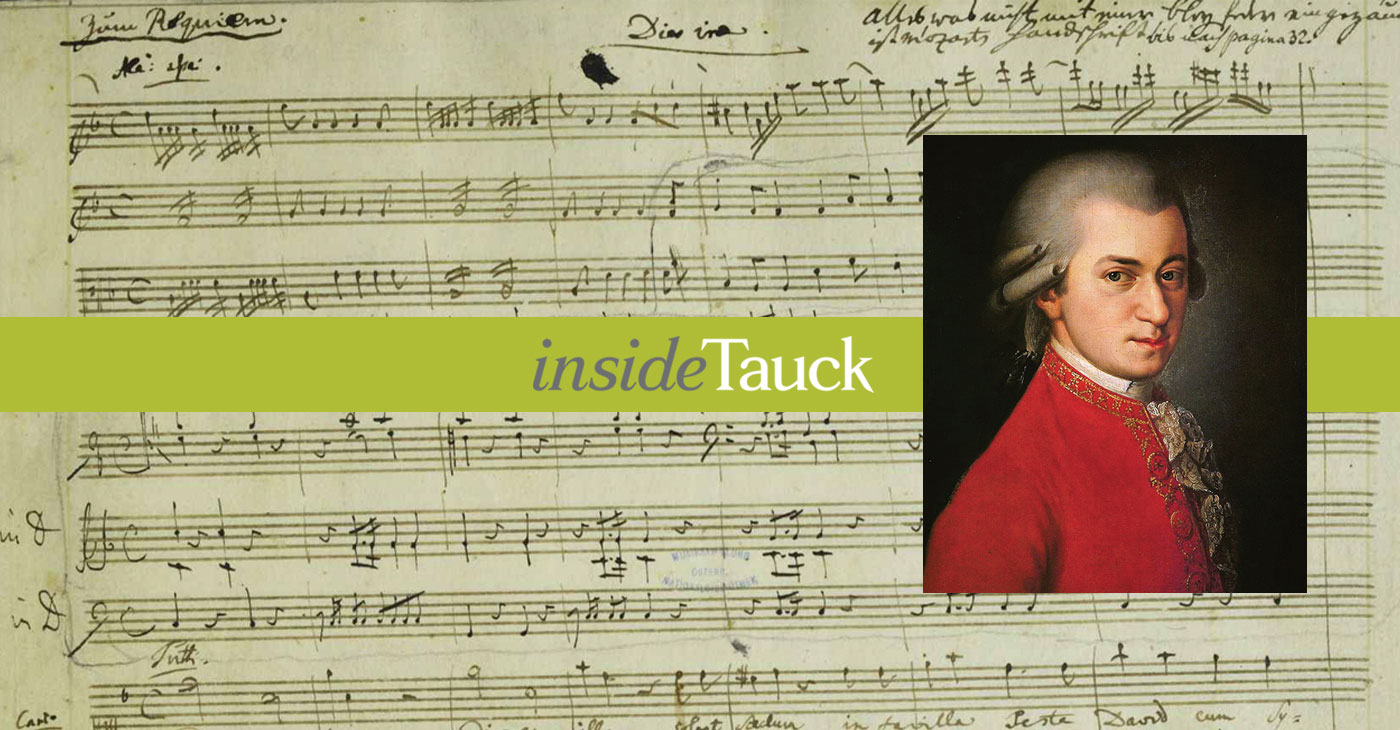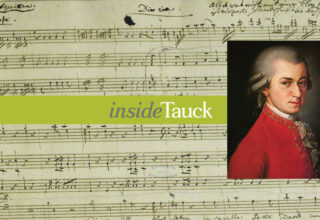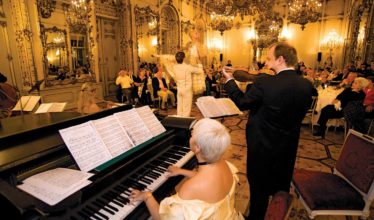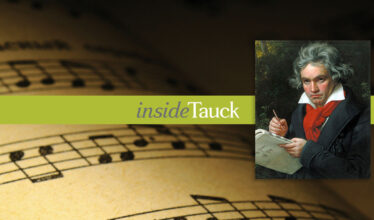Exclusively for Tauck, join Michael Shaw, Tauck Maestro, for a presentation on the life and career of Wolfgang Amadeus Mozart as a performer and composer. Michael will discuss Mozart’s background and historical significance, and provide insights into a few of his most important compositions. As there is so much great music, Michael will also provide a curated playlist to go along with his discussion.
Michael has been a Tauck “Maestro” on our Musical Magic Along The Blue Danube river cruises since 2010, and a Tauck Director along the Rhine since 2017; he has lived in Basel, Switzerland, since 2013. Michael studied at the San Francisco Conservatory of Music and earned his PhD in historical musicology at Columbia University; he has a historical – and musical – passion for 1790–1830 Vienna. His previous insideTauck presentation, on the life and music of Ludwig van Beethoven, remains one of our most accessed insideTauck events.
Mozart: Life in Music (1763-81)
This first playlist is music by Wolfgang and contemporaneous works by important musicians Wolfgang encountered in his first 25 years, between the Grand Journey in 1763 and the premiere of Idomeneo in Munich in 1781.
The first 12 tracks are works from the Grand Journey, 1762-5. First, a Sonata for Violin and Keyboard, one of the six such sonatas that Wolfgang had published in Paris in 1763, his first compositions published. Next, A symphony by Johann Christian Bach, published in 1765, just when the Mozarts were in London, followed by a violin sonata that Wolfgang had published during his time in London. Lastly, a keyboard sonata by J.C.Bach, in E major, an important work for young Wolfgang, who reworked this sonata as a Concerto during his Italian Journeys.
The next tracks are related to the Italian Journeys: first an aria and a trio from Lucio Silla, Mozart’s third opera commission from Milan, then his Symphony No.44 (K81), which he composed during the Italian Journeys and likely had performed in one of his many concerts on the peninsula. During his stay in Rome, the 14-year-old Mozart performed a legendary feat: while visiting the Sistine Chapel, he heard Allegri’s Miserere, the next work on the playlist. This piece was protected; it was only performed at the Sistine Chapel, and printed copies were not available outside the Chapel. After hearing it performed, Mozart sat down and transcribed it, almost perfectly, from memory. Finally, another work composed at this time, which he also likely performed during his Italian Journeys, a keyboard concerto, a reworking of the sonata by J.C.Bach from above.
The next 18 tracks are Salzburg works, from the 1770s, beginning with a symphony by one of Salzburg’s greatest symphonists, Leopold Mozart. Next are examples of sacred music, which Mozart composed in his duties as composer for the Archbishop’s court: Exultate jubilate and the Gloria from his Missa brevis (K194). But Mozart didn’t only write music for the Archbishop: next we have examples of the many secular works Mozart composed, the “Haffner” serenade (named after an important Salzburger, Sigismund Haffner, for whom it was composed), and two songs, the first quite funny.
That brings us to Mozart’s trip through Mannheim and Paris in the latter 1770’s. When Mozart sent his sonata in C major (K309) back home to Salzburg, his sister and father commented that it demonstrates the affected mannerisms of Mannheim piano music. The leader of the orchestra at Mannheim during Mozart’s stay there was Johann Christian Cannabich. His symphony in B-flat is next on the playlist. Mozart’s keyboard sonata in A minor, composed in Paris, exemplifies the fiery manner of keyboard writing then popular in that city. The “Paris” Symphony and a Violin sonata round off the examples from Mozart’s time in Paris.
Finally, two numbers from Idomeneo, an aria and a quartet, composed for Munich at the turn of 1781.
Mozart: Life in Music (1781-91)
This second playlist is a small representation of Mozart’s output during his decade in Vienna. We begin with a sonata for violin and keyboard, the first works Mozart had published after arriving in Vienna, followed by two numbers from The Abduction from the Seraglio (Die Entführung aus dem Serail): a duet, and an aria for a bass, some say the first great buffo (comic) aria written for the bass voice. Next I’ve included another example of Mozart reworking another composer’s music. This time, a Prelude and Fugue by Johann Sebastian Bach, which Mozart scored for a string trio (Violin, Viola, Cello). When Mozart and Constanze travelled to Salzburg in 1783, Mozart was working on his “Great” C minor mass, which he never completed, but was nonetheless performed in Salzburg. I’ve included the Kyrie, Sanctus, and Benedictus. Of the 12 keyboard concertos that Wolfgang composed and performed in 1784-85, I’ve chosen the one in A major (No. 23, K488). All of the concertos are great, there’s no doubt, but the second movement of the A major concerto is one of the most beautiful works ever written. Period.
Though popular knowledge says that Mozart composed effortlessly (which, is partly true), his “Haydn” String Quartets (so named because they were dedicated by Mozart to Haydn) show that Mozart did have to put in a great deal of effort sometimes. Compared to most of Mozart’s manuscripts, the manuscripts for these quartets show an uncommon amount of scratching out and revising and reworking. I’ve chosen the quartet in E-flat major.
After the finale of Act II from Figaro, I have a couple of German Dances, two of the many dances that Mozart composed in his capacity as Kammermusicus to Emperor Joseph II. Following that, Mozart’s “Musikalischer Spass,” the “Musical Joke.” It’s not always easy to pin down exactly what the joke is for most of this composition: it seems to be Mozart playing the part of the graceless, awkward composer. However, in the two movements I’ve chosen the “jokes” are easy to hear: the violin veering into the wrong key at the end of a lengthy cadenza, and the assortment of wrong notes on the final cadence. Whether it is meaningful or not, this was the first work Mozart composed after hearing news of his father’s death. Perhaps it is a fond remembrance of his father’s lighter, humorous side. In honor of Beethoven’s visit to Vienna, next on the playlist is a Piano Quintet that Beethoven wrote in 1785, two years before meeting Mozart. For Don Giovanni, I’ve included the Overture and opening scene, as well as the very end, the Act II finale. From Mozart’s less successful, less productive period, I’ve included the “Jupiter” symphony. Even when he was in a rut he was still composing masterpieces like this! And from Cosi fan tutte, you’ll hear the Act I finale.
From 1791, Mozart’s final year, I’ve started with a String Quintet and an aria from La clemenza di Tito. Following two numbers from The Magic Flute (Die Zauberflöte)—a trio and the final chorus—you can hear a cantata (a vocal work for soloists, chorus, and orchestra) that Mozart wrote for his Masonic lodge. The playlist ends with the Clarinet Concerto and four movements from the Requiem: the Requiem aeternam (which he completed), the Confutatis (for which he wrote the vocal parts and the bass line), the Agnus Dei (which was completely composed by his pupil Süssmayer, who said however that he was in possession of Mozart’s notes), and the final movement, the Communio, which was similarly composed by Süssmayer, though for the very end, Süssmayer brings back music from the Requiem aeternam, which Mozart did compose.
I hope you enjoy, and please send any questions or comments to me at shaw.t.michael@gmail.com!




Would love to join future blogs
I signed on to listen to yesterday’s presentation, and about 1/4 of the way through, my computer screen started flipping. I reloaded the presentation 3 times, with the same results. Unfortunately, I was not able to finish the presentation that I was looking forward too.
Hi Nancy,
Sorry to hear that you were having technical difficulties. If you’d like to continue watching the presentation, please scroll up to the top of this page and there’s a recording of the presentation.
Thanks,
Tauck